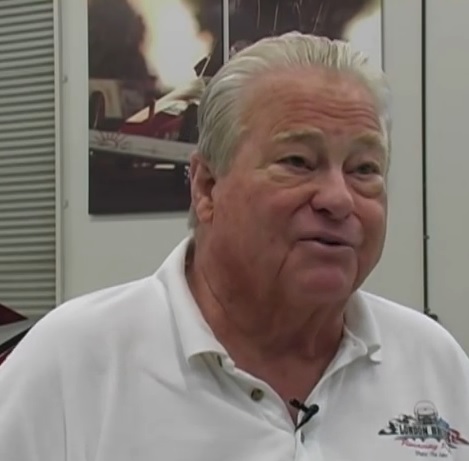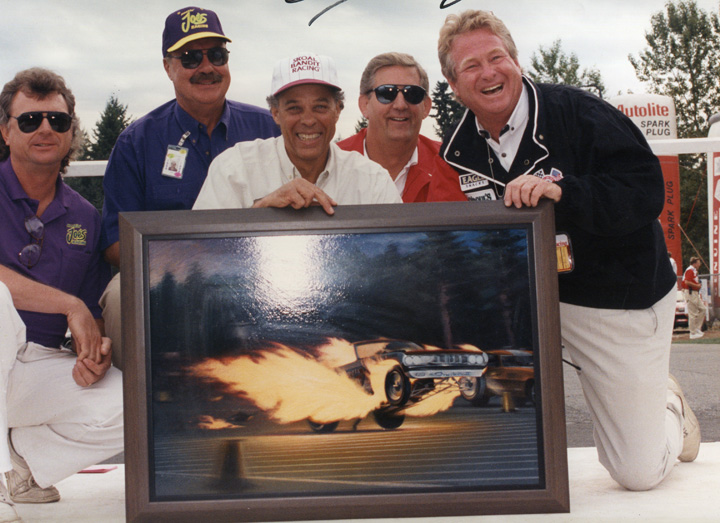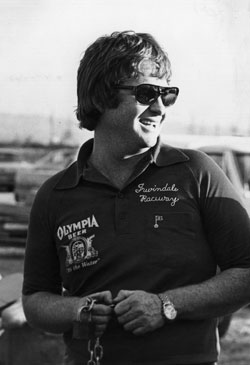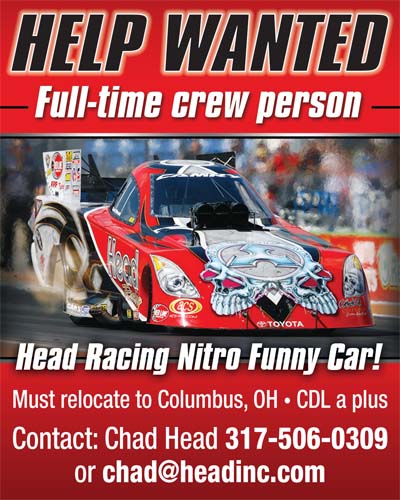DONER AND SEATTLE: COULD MAGIC HAPPEN AGAIN?
 Walk through a stand of fir trees to the edge of the Pacific Raceways dragstrip on a crisp, windy October day and stare down the lanes. It just might be possible to hear the echoes of the roar of 64 Funny Cars or the cheers of the fans from the 1970 Northwest National Open as they leaped from their seats to watch Jerry “The King” Ruth, Ed “The Ace” McCulloch, and Dick “The Joker” Kalvoda scream down the quarter-mile.
Walk through a stand of fir trees to the edge of the Pacific Raceways dragstrip on a crisp, windy October day and stare down the lanes. It just might be possible to hear the echoes of the roar of 64 Funny Cars or the cheers of the fans from the 1970 Northwest National Open as they leaped from their seats to watch Jerry “The King” Ruth, Ed “The Ace” McCulloch, and Dick “The Joker” Kalvoda scream down the quarter-mile.
That was back when the property was called Seattle International Raceway and a gentleman named Bill Doner spun his unique brand of confetti-and-chaos magic there. Crowds literally went wild, even tore the fences down and ran onto the racing surface. And drag racing out-“cooled” the Pacific Northwest’s signature unlimited hydroplane scene. This dragstrip was the place to be.
 Walk through a stand of fir trees to the edge of the Pacific Raceways dragstrip on a crisp, windy October day and stare down the lanes. It just might be possible to hear the echoes of the roar of 64 Funny Cars or the cheers of the fans from the 1970 Northwest National Open as they leaped from their seats to watch Jerry “The King” Ruth, Ed “The Ace” McCulloch, and Dick “The Joker” Kalvoda scream down the quarter-mile.
Walk through a stand of fir trees to the edge of the Pacific Raceways dragstrip on a crisp, windy October day and stare down the lanes. It just might be possible to hear the echoes of the roar of 64 Funny Cars or the cheers of the fans from the 1970 Northwest National Open as they leaped from their seats to watch Jerry “The King” Ruth, Ed “The Ace” McCulloch, and Dick “The Joker” Kalvoda scream down the quarter-mile.
That was back when the property was called Seattle International Raceway and a gentleman named Bill Doner spun his unique brand of confetti-and-chaos magic there. Crowds literally went wild, even tore the fences down and ran onto the racing surface. And drag racing out-“cooled” the Pacific Northwest’s signature unlimited hydroplane scene. This dragstrip was the place to be.
That was a long, long time ago. Carried on today’s stiff breeze at Pacific Raceway is a stale scent of squandered potential and a legacy of legal feuding. The property, and a piece of Doner’s heart, is up for sale.
“I left a lot of my soul there,” Doner said. “I still have a lot of feelings about that racetrack.”
Even this salesman extraordinaire, who routinely tossed the word “impossible” over his shoulder and carried out his grandiose schemes in style as general manager from 1969-1975, was surprised at the owners’ reported but unpublished asking price of $37 million.
“They’re trying to turn it into a business park,” California-based Doner said of the Fioritos who opened the facility on its excavation-business site in the 1960s. He told Competition Plus publisher Bobby Bennett that current operator Jason Fiorito, the family’s third-generation property manager, “has got it priced kind of on a square-foot basis – I’m just telling you what I hear – at $37 million. I don’t know that the economy in Seattle or here or anywhere else will support that.”
Doner said occasionally, in a fit of sentiment, he fantasizes that he could be ringmaster at this Seattle circus again, considering he said he “always felt bad I left as early as I did.” He said, “I might have that feeling, then 10 minutes later I’d think about all the things that happened and I’d think, ‘Don’t think like that!’ “
But he can’t help it.
“We did things people said we couldn’t do there. And those were very uplifting. The things we were doing in Seattle were things nobody else was doing,” Doner said. “I had some wonderful, wonderful times there. I had some tough times, but the highs were really great. There were a lot of highs in Seattle.”
 Bill Doner [far right] and Jim Rockstad [second from right] enjoyed many memories from Pacific Raceways, including this wild ride from Don Prudhomme. Photo courtesy of www.capracing.comAn eternal optimist and a man with tremendous confidence in his own ability to whip up a crowd, Doner thought again of the possibility of returning to Seattle.
Bill Doner [far right] and Jim Rockstad [second from right] enjoyed many memories from Pacific Raceways, including this wild ride from Don Prudhomme. Photo courtesy of www.capracing.comAn eternal optimist and a man with tremendous confidence in his own ability to whip up a crowd, Doner thought again of the possibility of returning to Seattle.
“Yeah, I suppose if the price was right, I suppose I wouldn’t mind taking a whack at it,” he said. “They’ve got some real nice grandstands in there now, and I still have ideas. My brain hasn’t quit working. I don’t know – If somebody called me up and asked me to go take a look at it, I’d do that.”
No, Doner’s brain hasn’t quit working. Like a TV drama he just clicked off five minutes before, he vividly recalled his favorite moments there. His proudest moment, he said one would have to say, was “the very first Northwest National Open I ran in 1970, which kind of saved my bacon and made drag racing happen in the Northwest. That event and the shot that I took in a bad-weather month to do it was certainly so uplifting I can’t even tell you. I think back at it, I get tears in my eyes.
“Then I think one of those 64 Funny Car races where we had so many people who came all night and the race went off like perfection: done at 11, even though there were people all over the racetrack. They smashed the fences down there were so many people. But it was really huge.”
Unlike at the eighth-mile track at Eugene, Ore., where folks routinely stormed the tower and threated to burn it down, Doner said, “We never had any riot conditions in Seattle, ever. We had crowds that were so big they were hard to manage. We weren’t equipped to handle things that big. Nobody was, and certainly we weren’t. Nobody had seen crowds like that – nobody – in the whole country. The NHRA, at their national events, if they’d had that kind of crowd at night and tried to handle it . . . holy crap!”
His Seattle tower was a source of pride, he said.
“When we built that tower, we went down and scrounged the money from the Olympia Brewing Company to build it. That was pretty exciting, too,” he said. “We had a little wood tower and we opened it up and people thought that was kind of a cool thing. It was the first new tower in that part of the country. And I would say it was as nice then as what they had at Pomona or anywhere. Orange County’s tower was nicer, but certainly nobody else’s was. I liked that. I was excited about that.
“I’d say Seattle was THE track that put me on the map, not ‘one of,’ ” Doner said. “Without Seattle . . . I mean, Orange County was good, but nothin’ was like Seattle. Seattle did it, got the whole country looking at us. That was the track.”
 Bill Doner back in the day. What will become of it now is uncertain.
Bill Doner back in the day. What will become of it now is uncertain.
Lamenting that “I suppose they’ve got to do what they’ve got to do,” Doner sympathized a bit with the Fiorito family.
“Like I did, they’ve battled pretty hard with the neighbors and everybody. Pretty soon you get a little beat down doing that,” he said. But he said, “I’d feel bad if they just knocked the racetrack out.”
Since he took over the facility management in 2002, Jason Fiorito has promised improvements that came in infinitesimal increments (a restroom here, a repaired section of the track there) and never on the grand scale that he crowed about. He bragged that gravel from the Pacific Raceways site provided the foundation to a third runway at nearby Sea-Tac International Airport. But an investigation by Competition Plus discovered that Pacific Raceways contributed only a single-digit percentage of the airport’s needs in construction of the runway but that the Fioritos’ business received somewhere in the neighborhood of $2 million for its gravel.
Little, if any, of that approximately $2 million – which Fiorito said was to provide funds for racetrack improvements – went to the dragstrip. He hauled out fancy renderings of a “master plan” that sounded splendid on paper, with revenue-producing ventures and a new fire station to serve (and appease) the continually cranky neighbors.
That plan fizzled. Then last summer at Indianapolis, Fiorito excitedly shared with Competition Plus his vision for a high-tech automotive research facility on the Pacific Raceways campus that once again sounded promising. After attracting the support he claimed to have courted for years from local politicians, Fiorito announced this fall that the price tag had outgrown the family’s bank account and that the facility was for sale.
Even a recent flap about Pacific Raceways failing to pay a cancer-research charity for its fundraising work at the track highlighted the facility’s financial woes. A KIRO-TV report called out Fiorito for dragging his feet in paying volunteers for the Leukemia and Lymphoma Society the $2,100 he owed them from August.
Fiorito told the TV station, “We’re in some cash management issues right now. Like a lot of businesses, it doesn’t mean we don’t care and it doesn’t mean we won’t make good on our obligations. We’re sorry our late payment has caused people some hardships.”
 He said he had hoped walk-up sales would cover his commitment to the charity – much like gravel sales for the airport runway would pay for track improvements.
He said he had hoped walk-up sales would cover his commitment to the charity – much like gravel sales for the airport runway would pay for track improvements.
All grievances aside, the latest development throws a monkey wrench into the NHRA’s presence in the Pacific Northwest. The sanctioning body has said it is proceeding as normal, assuming a 2015 Northwest Nationals will go on.
Jim Rockstad, who as general manager of Seattle International Raceway from 1976-2001 constantly feuded openly with the Fioritos, was Doner’s protégé and his successor. And he, too, reacted to the news of the facility going on the auction block with sadness.
“I recently heard the news of a possible sale of Pacific Raceways, east of Kent, Washington. It'll be a huge void for motorsports in the Northwest if the land is sold for housing,” Rockstad said. “There is a steep history of drag racing dating back to the opener on July 4th, 1960, at that facility. Without a doubt it would be a crushing blow to Northwest motorsports. Pacific Raceways has been the center of drag racing in the Northwest for all of those years.”
Rockstad bore the brunt of criticism about the deteriorating conditions in the late 1990s and early 2000s and found himself on the spot when racer Whit Bazemore told an ESPN-TV audience that the facility was “a national disgrace.” But Rockstad’s hands much of the time were tied by legal skirmishes the Fioritos had with King County and even their own family members. The friction ceased only when Rockstad’s contract expired. After that, Jason Fiorito assumed the responsibility. And the facility looks virtually the same today as it did New Year’s Day 2002.
However, Rockstad said, “There is no other major facility in the area that could take on the NHRA national event that currently resides there. The echo of nitro drag racing has been music to the ears of Northwestern car buffs, along with a special lengthy history of the sport.”
It’s too early to tell whether the music has died, but this slice of “American Pie” just isn’t the same.
The act of cutting and pasting articles from this publication to a message board is a clear copyright violation as is pulling photos to post on social media sites. All articles and photography published in CompetitionPlus.com are protected by United States of America and International copyright laws unless mentioned otherwise. The content on this website is intended for the private use of the reader and may not be published or reposted in any form without the prior written consent of CompetitionPlus.com.





































